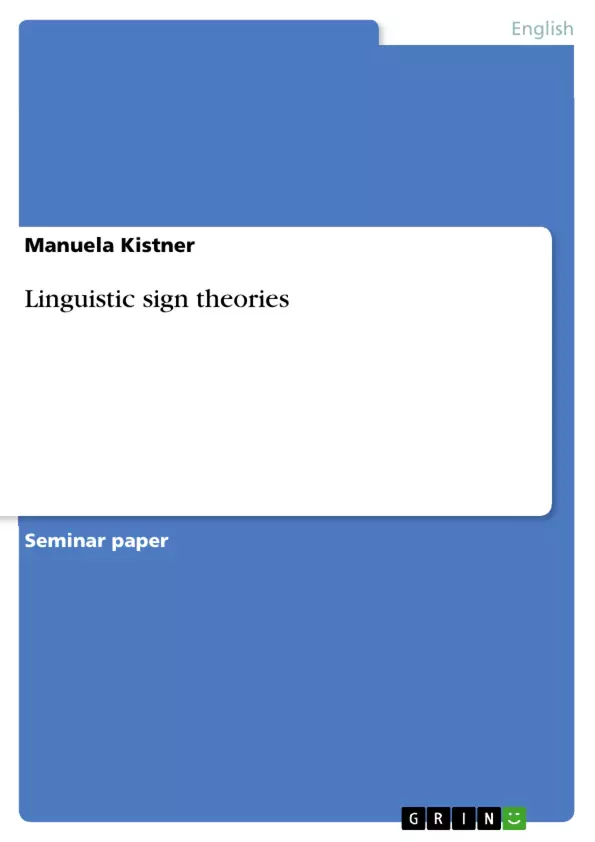We seem to be a species that is driven by “a desire to make meanings” (Chandler: 1995) by creating and interpreting signs. Indeed, it is a fact that “we think only in signs” (Peirce: 1931-58, II.302). These signs can have the shape of sounds, images, objects, acts or flavours. Since these things do not have an intrinsic meaning, we have to give them a meaning so that they can become signs. Peirce states that “Nothing is a sign unless it is interpreted as a sign” (Peirce: 1931-58, II.172). This means that everything can become a sign as long as it ‘signifies’ something – refers to or stands for “something other than itself” (Chandler: 1995). Our interpretation of signs is an unconscious process in our minds as we constantly relate the signs we experience to a system of conventions that is familiar to us.
This system of conventions and the use of signs in general is what semiotics is about. There are three major models that give a detailed explanation of the constitution of a sign; these are the models of Ferdinand de Saussure’s, Charles Sanders Peirce’s and Karl Bühler’s model. At first, they will be presented in detail and secondly, there will be a brief discussion about them.
Table of Contents
- Introduction
- Main Part
- Ferdinand de Saussure's model
- signifiant and signifié
- concept and sound pattern
- relation & value
- arbitrariness & convention
- Charles Sanders Peirce's model
- triadic model I: Representamen, Interpretant, Object
- triadic model II: sign vehicle, sense, referent
- index, icon and symbol
- Karl Bühler's model
- Bühler's first model
- Bühler's second model
- Ferdinand de Saussure's model
- Conclusion
Objectives and Key Themes
The main objective of this text is to provide a detailed analysis of the constitution of a sign using three major models from Ferdinand de Saussure, Charles Sanders Peirce, and Karl Bühler. The text aims to explain the concept of a linguistic sign, exploring its components, relationships, and relevance in communication. It also delves into the role of convention and interpretation in assigning meaning to signs.
- The structure and components of a linguistic sign
- The relationship between signifier and signified
- The significance of context and convention in interpreting signs
- The role of sound patterns and concepts in communication
- The different models of the sign proposed by Saussure, Peirce, and Bühler
Chapter Summaries
- Introduction: This chapter introduces the concept of a sign and its importance in human communication. It highlights that signs are not intrinsically meaningful and need interpretation to be understood. The chapter introduces the three major models of the sign discussed in the text.
- Main Part - Ferdinand de Saussure's model: This section delves into Saussure's model of the linguistic sign. It explains the concepts of signifiant (signifier) and signifié (signified), their relationship in the process of signification, and the role of convention in establishing this relationship. The chapter also discusses the importance of sound patterns and concepts in forming linguistic signs.
- Main Part - Charles Sanders Peirce's model: This chapter explores Peirce's triadic model of the sign, examining the relationship between the representamen, the interpretant, and the object. It also introduces Peirce's categorization of signs into index, icon, and symbol, highlighting their distinct characteristics and roles in communication.
- Main Part - Karl Bühler's model: This section presents Bühler's model of the sign, emphasizing its focus on the communicative function of language. The chapter explains Bühler's first and second models, detailing their specific components and their contributions to understanding the role of signs in communication.
Keywords
The text focuses on key terms and concepts like linguistic sign, signifier, signified, signification, sound pattern, concept, convention, interpretation, index, icon, symbol, triadic model, and communication. The models of Saussure, Peirce, and Bühler are central to the analysis, and their theories provide a foundation for understanding the relationship between signs and meaning.
- Citar trabajo
- Manuela Kistner (Autor), 2005, Linguistic sign theories, Múnich, GRIN Verlag, https://www.grin.com/document/71829



